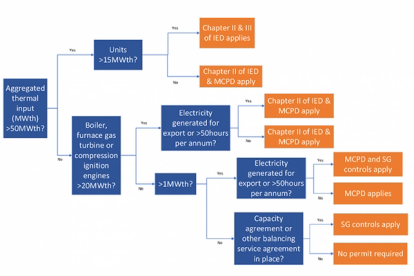
Cultural heritage: Indigenous and cultural heritage values driving sustainable development
by Flavia Kiperman
View post

Regulation of peaking power plants under the Environmental Permitting (England and Wales) Regulations (EPR) 2016 (as amended) is a complicated issue. This briefing note summarises the requirements for developers of peaking plants. Peaking plant are electricity generating plant that support the national grid when there is a high demand for electricity compared to base load supply.
The Industrial Emissions Directive (IED) requires combustion plant with an aggregated rated thermal input capacity (MWth) over 50 MWth (hereafter referred to as Large Combustion Plant or LCPs) obtain and comply with the conditions of an environmental permit. The stipulated permit conditions must be based on Best Available Techniques (BAT). In addition to the Chapter II requirements, the IED requires that permits for LCPs comprised of units >15MWth implement the ‘special provisions’ of Chapter III of the IED. In England and Wales, these requirements are implemented via the EPR as Part A(1) installation activities.
BAT for IED sites are described within BAT Reference documents (Brefs) produced by the European Commission. In the case of LCPs, however, the techniques described within the Bref aren’t suited to peaking plant. In response to this, the Department of Energy and Climate Change (DECC) commissioned a report on ‘Developing BAT for combustion plants operating in the balancing market’ (published 2016). Further to this, the Environment Agency (EA) produced draft guidance in 2018 for Chapter III peaking plant only1.
The EA apply the Bref, DECC and its guidance document in its determination of permit applications for large peaking plant.
The following are the key considerations when assessing the application of BAT: • Suitability of technology for proposed use;
To optimise the financial performance of a site, SLR recommends that developers of such sites consider these matters from the outset of their projects as the points are linked and will affect the business model.
Boilers, furnaces, gas turbines and compression ignition engines over 20MWth but less than 50MWth are required to obtain a Part B environmental permit by the EPR. Part B site’s must also employ BAT. BAT for these facilities is described in the Secretary of State’s ‘Environmental Permitting Technical Note 1/1(18) Reference document for combustion plant of 20 to 50th thermal capacity’. Regulation of Part B sites is only undertaken for the purposes of managing emissions to air. As such, the BAT requirements are less onerous than those for LCPs.
The Medium Combustion Plant Directive (MCPD), introduced in 2015, requires all combustion plant with rated thermal input between 1MWth and 50MWth obtain and comply with the conditions of a permit. LCPs regulated as Chapter III plant are exempt from the requirements of the MCPD whereas Chapter II plant are not. In England and Wales, the MCPD is implemented via the EPR.
In transposing the requirements of the MCPD into the EPR, Defra introduced additional controls for Specified Generators (SGs). SGs are those MCPs that generate electricity for >50hrs per annum (incl. testing) or export electricity to the grid. <1MWth units are included too if they export electricity under a capacity market or other balancing service agreement. LCPs regulated as IED Chapter II and III plant are exempt from the requirements of the SG Controls.
In England and Wales, the SG Controls are implemented via the EPR.
The requirements described above are summarised in Figure 1.

Figure 1 - Environmental Permitting - peaking plant
The regulations surrounding the operation of peaking power plants in England and Wales are complex and require careful consideration by developers.
The Industrial Emissions Directive (IED) requires Large Combustion Plants (LCPs) with an aggregated rated thermal input capacity over 50 MWth to obtain and comply with an environmental permit based on Best Available Techniques (BAT).
For LCPs that are peaking plants, specific BAT guidance has been developed by the Department of Energy and Climate Change (DECC) and the Environment Agency (EA).
Part B Environmental Permits are required for boilers, furnaces, gas turbines and compression ignition engines between 20MWth and 50MWth.
The Medium Combustion Plant Directive (MCPD) requires all combustion plants with rated thermal input between 1MWth and 50MWth to comply with permit conditions. Specified Generator Controls (SG Controls) are also introduced for MCPs that generate electricity for more than 50 hours per annum or export electricity to the grid.
Developers must carefully consider these requirements from the outset to optimize their financial performance while ensuring compliance with the regulations.
SLR can offer numerous services for the Environmental Permitting of peaking power plants. SLR can: • Undertake BAT Assessments;
1 EA – BAT guidance for >50MWth gas and liquid fuel combustion plant exporting electricity under commercial arrangements for <1500 hours per annum.

by Flavia Kiperman

by Jasper Schrijvers , Matthew Hoare

by Clodagh Connolly, Nicola Inge, Andres Schottlaender